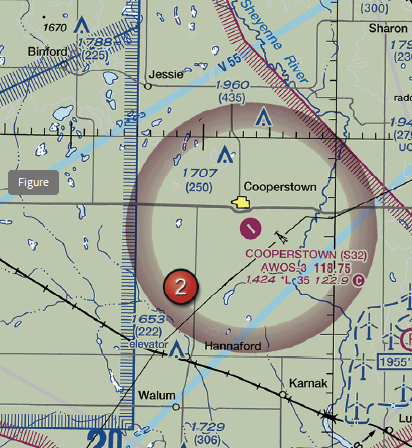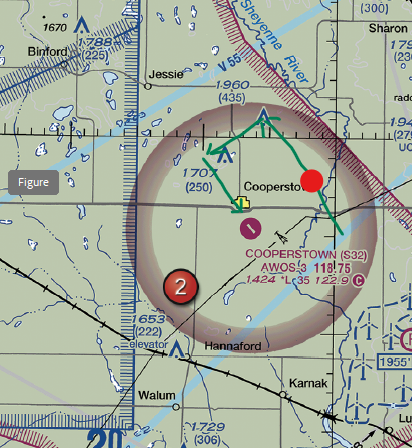FAA(Refer to FAA-CT-8080-2H, Figure 26, area 2.) While monitoring the Cooperstown CTAF you hear an aircraft announce that they are midfield left downwind to RWY 13. Where would the aircraft be relative to the runway?
- ✅A:The aircraft is East.
- ❌B:The aircraft is South.
- ❌C:The aircraft is West.

FAA-CT-8080-2H Figure 26 Area 2 - Click to enlarge.
Answer Figure

Click to enlarge answer figure
Explanations
- A: Correct. A left downwind to RWY 13 means the aircraft is flying parallel to the runway heading (130°), on a heading of 310°. In a left pattern, the runway is to the pilot's left — placing the aircraft east of RWY 13. For a commercial drone operator, understanding this is crucial to maintaining safety and avoiding potential collision with manned aircraft. Misinterpretation could lead to regulatory violations and potential fines, impacting the business's reputation and profitability.
- B: Incorrect. South of RWY 13 would place the aircraft near the base leg or final approach, not midfield downwind. Misunderstanding this could lead to a drone operator flying in the wrong area, potentially causing safety hazards and regulatory violations, which could negatively impact the business.
- C: Incorrect. West of RWY 13 would place the aircraft on the right side of the pattern or departing away, not aligned with a left downwind entry. Misinterpretation could lead to safety hazards and regulatory violations, impacting business operations and profitability.
🧭 Instructor Note
Why This Matters for Your Business
Understanding runway orientation and traffic patterns is crucial for operating drones near airports. Misinterpretation can lead to safety hazards, regulatory violations, and potential fines, impacting your business's reputation and profitability.
Safety & Liability Considerations
Operating a drone without a clear understanding of aircraft positions can lead to potential collisions. It's essential to maintain safety and avoid damage, injury, and potential fines or legal issues.
Consider This Scenario
Imagine a commercial drone operator conducting a real estate photography session near Cooperstown airport. The operator hears an aircraft announce its position as midfield left downwind to RWY 13. Misinterpreting the aircraft's position could lead to the drone pilot being unaware, potentially causing a safety hazard and regulatory violation. Correct interpretation ensures safe operations and successful completion of the task, enhancing client satisfaction and business reputation.
What the FAA is Testing
The FAA wants to ensure that drone operators understand runway orientation and traffic patterns. This knowledge is crucial for safe operations near airports and compliance with FAA regulations.
Business Success Strategy
Always ensure you understand the aircraft's position when operating near airports. Regular practice decoding CTAF calls and mapping aircraft positions on sectional charts can enhance your situational awareness, leading to safer operations, satisfied clients, and a successful drone business.
Memory Aid
Remember, when an aircraft announces they're midfield left downwind, the runway is on the aircraft's left side.
Enhanced References
FAA Aeronautical Chart User's Guide, Section on Traffic Patterns; FAA Advisory Circular AC 90-66B, Non-Towered Airport Flight Operations.
Related Concepts
- Standard traffic pattern legs: upwind, crosswind, downwind, base, final
- Runway orientation and magnetic headings
- Left-hand traffic pattern geometry
- CTAF communication and position reporting
ACS Code: UA.V.A.K3
Difficulty: intermediate
